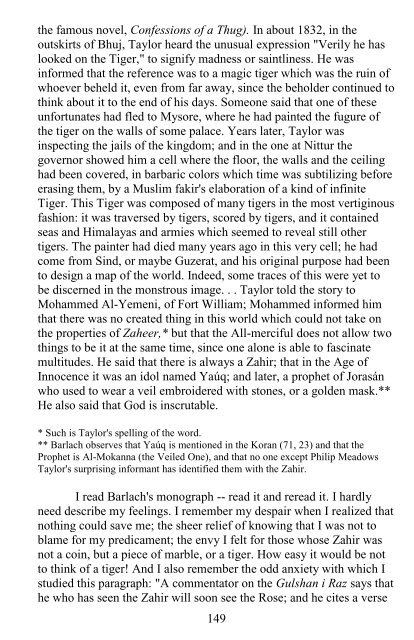Jorge Luis Borges - Labyrinths
Jorge Luis Borges - Labyrinths
Jorge Luis Borges - Labyrinths
You also want an ePaper? Increase the reach of your titles
YUMPU automatically turns print PDFs into web optimized ePapers that Google loves.
the famous novel, Confessions of a Thug). In about 1832, in the<br />
outskirts of Bhuj, Taylor heard the unusual expression "Verily he has<br />
looked on the Tiger," to signify madness or saintliness. He was<br />
informed that the reference was to a magic tiger which was the ruin of<br />
whoever beheld it, even from far away, since the beholder continued to<br />
think about it to the end of his days. Someone said that one of these<br />
unfortunates had fled to Mysore, where he had painted the fugure of<br />
the tiger on the walls of some palace. Years later, Taylor was<br />
inspecting the jails of the kingdom; and in the one at Nittur the<br />
governor showed him a cell where the floor, the walls and the ceiling<br />
had been covered, in barbaric colors which time was subtilizing before<br />
erasing them, by a Muslim fakir's elaboration of a kind of infinite<br />
Tiger. This Tiger was composed of many tigers in the most vertiginous<br />
fashion: it was traversed by tigers, scored by tigers, and it contained<br />
seas and Himalayas and armies which seemed to reveal still other<br />
tigers. The painter had died many years ago in this very cell; he had<br />
come from Sind, or maybe Guzerat, and his original purpose had been<br />
to design a map of the world. Indeed, some traces of this were yet to<br />
be discerned in the monstrous image. . . Taylor told the story to<br />
Mohammed Al-Yemeni, of Fort William; Mohammed informed him<br />
that there was no created thing in this world which could not take on<br />
the properties of Zaheer,* but that the All-merciful does not allow two<br />
things to be it at the same time, since one alone is able to fascinate<br />
multitudes. He said that there is always a Zahir; that in the Age of<br />
Innocence it was an idol named Yaúq; and later, a prophet of Jorasán<br />
who used to wear a veil embroidered with stones, or a golden mask.**<br />
He also said that God is inscrutable.<br />
* Such is Taylor's spelling of the word.<br />
** Barlach observes that Yaúq is mentioned in the Koran (71, 23) and that the<br />
Prophet is Al-Mokanna (the Veiled One), and that no one except Philip Meadows<br />
Taylor's surprising informant has identified them with the Zahir.<br />
I read Barlach's monograph -- read it and reread it. I hardly<br />
need describe my feelings. I remember my despair when I realized that<br />
nothing could save me; the sheer relief of knowing that I was not to<br />
blame for my predicament; the envy I felt for those whose Zahir was<br />
not a coin, but a piece of marble, or a tiger. How easy it would be not<br />
to think of a tiger! And I also remember the odd anxiety with which I<br />
studied this paragraph: "A commentator on the Gulshan i Raz says that<br />
he who has seen the Zahir will soon see the Rose; and he cites a verse<br />
149


